By enriching uranium at the 60 percent level of purity, Iran is applying its own strategy of diplomatic leverage, Gareth Porter reports.
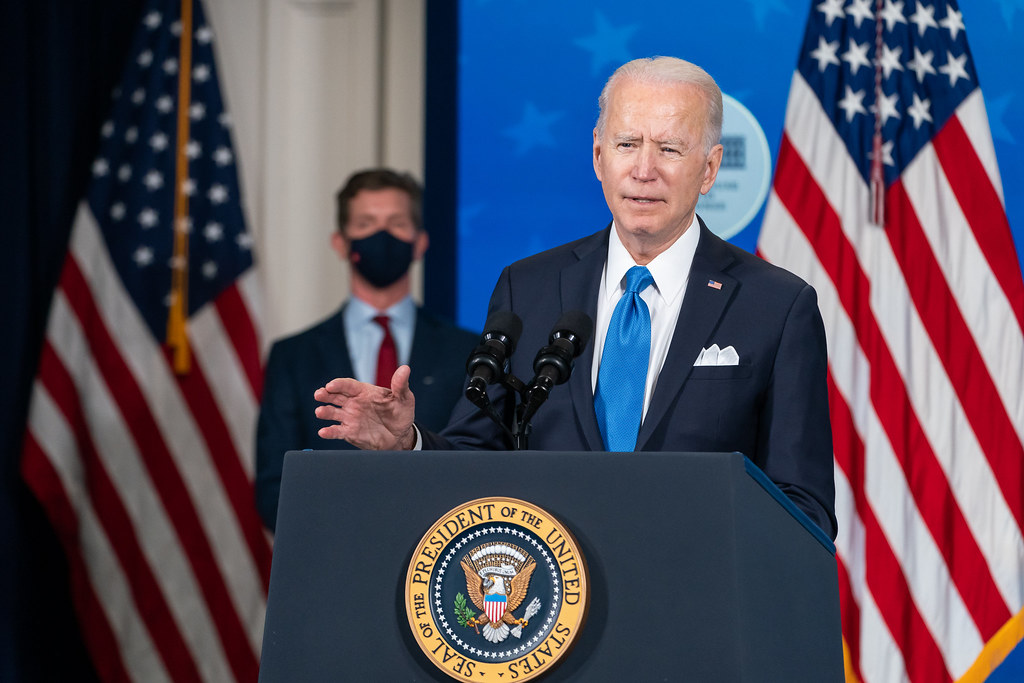
U.S. President Joe Biden. (White House, Adam Schultz)
 The Biden administration signaled once again at the April 9 Vienna meeting on the Iran nuclear deal that it intends to maintain Trump-era Iran sanctions in an effort to win political and military concessions going well beyond the original deal itself. Team Biden continued to insist during the conference that Iran return to full compliance with the nuclear agreement without any reciprocal U.S. commitment to remove the sanctions President Donald Trump imposed after abandoning the agreement in 2018.
The Biden administration signaled once again at the April 9 Vienna meeting on the Iran nuclear deal that it intends to maintain Trump-era Iran sanctions in an effort to win political and military concessions going well beyond the original deal itself. Team Biden continued to insist during the conference that Iran return to full compliance with the nuclear agreement without any reciprocal U.S. commitment to remove the sanctions President Donald Trump imposed after abandoning the agreement in 2018.
The Biden administration’s stance on the Joint Comprehensive Plan of Action (JCPOA) has already provoked a forceful response from Iran. Rather than enriching uranium at the 20 percent level that was used before Washington began making its new demands, Tehran has begun enriching to 60 percent purity.
In a video press conference with journalists after the first round of the “Joint Commission” of the JCPOA in Vienna, an unnamed “senior official” implied that the Biden administration intends to maintain sanctions on Iran, framing them as necessary political leverage. The unnamed U.S. official also griped about “repeated statements by Iranians that all sanctions imposed since 2017 have to be lifted.”
Asserting the Biden administration’s position on the JCPOA, the official stated: “[U]nder the deal the U.S. retains the right to impose sanctions for non-nuclear reasons, whether it’s terrorism or human rights violations or interference with our elections, et cetera.”
The official added, “[A]ll sanctions that are inconsistent with the JCPOA and inconsistent with the benefits that Iran expects from the JCPOA, we are prepared to lift. That does not mean all of them, because there are some that are legitimate.”
However, the official refused to clarify just how the Biden administration distinguishes between “legitimate” and “illegitimate” sanctions. The Biden administration’s deliberate ambiguity on that central point strongly suggests a determination to force Iran into making concessions on issues which happen to be Israeli priorities: lengthening the sunset dates of Iran’s key JCPOA obligations as well as imposing limits on its ballistic missile program and regional alliances.
Iran’s Position
Abbas Araghchi, Iran’s deputy foreign minister for political affairs, has made it clear that Iran will not bend to the Biden administration’s diplomatic coercion. Just before the Vienna meeting, he said, “The U.S. should remove … all sanctions that were reimposed after Trump’s withdrawal from the JCPOA or newly imposed or relabeled … and then we [will] verify and return to our commitments.”
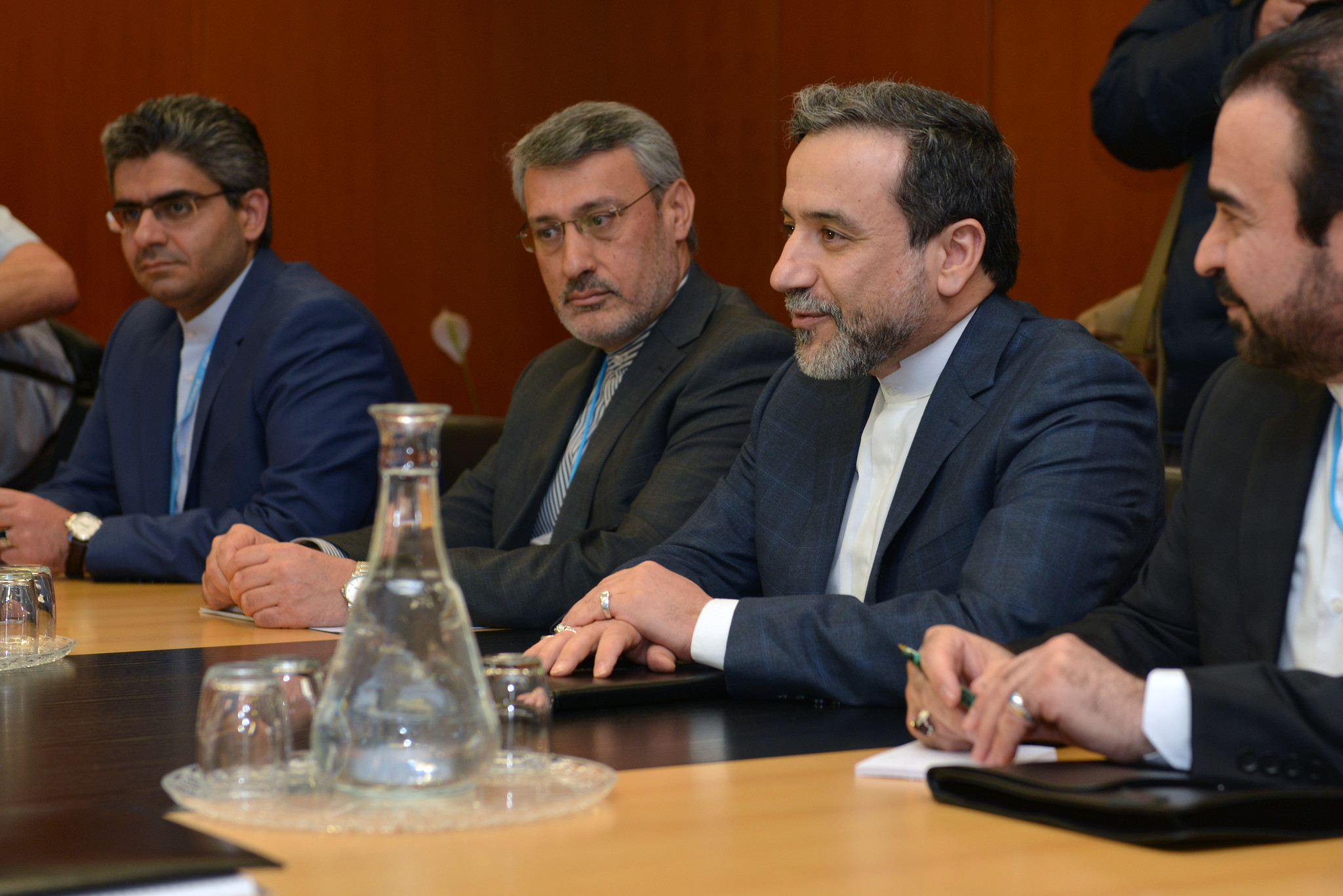
Nov. 24, 2015: Seyyed Abbas Araghchi, of Iran’s foreign ministry, second from right, at IAEA headquarters in Vienna. (IAEA Imagebank, Flickr, CC BY-NC-ND 2.0)
Further evidence of the obdurate U.S. strategy came in the form of comments made by Secretary of State Antony Blinken in a March 3 interview with PBS Newshour.
While crediting the JCPOA with having “put Iran’s nuclear program in a box,” Blinken ignored the fact that the agreement had resulted from Tehran’s acceptance of limits on its nuclear program for several years in return for the removal of U.S. and UN sanctions.
Blinken even framed the Trump administration’s withdrawal from the nuclear deal as though it were a consensus U.S. policy rather than an extremist policy that Biden himself had attacked.
“When we pulled out of the nuclear agreement,” he said, “Iran then started to break out from that box. And it is now in a position where it is closer to having the ability to produce fissile material for a nuclear weapon on short order, in a matter of months.”
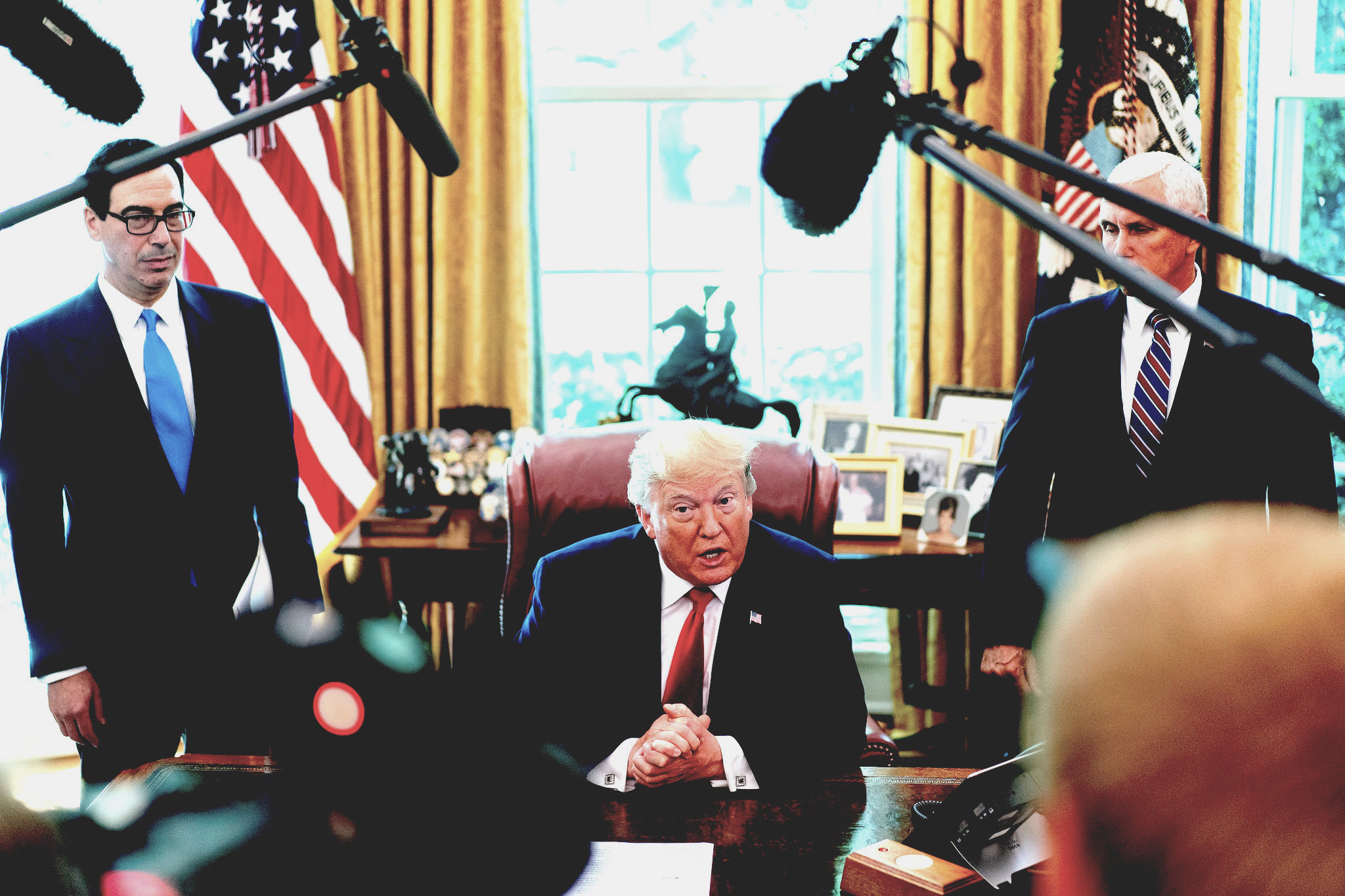
June 24, 2019: President Donald J. Trump, joined by Vice President Mike Pence and Treasury Secretary Steven Mnuchin, addressing reporters before signing further sanctions on Iran. (White House, D. Myles Cullen)
Blinken emphasized that the Biden administration has “a real interest in trying to put Iran back into that box.” Yet he downplayed the role of sanctions relief in returning to the original JCPOA. “We have been very clear that Iran has to come back into compliance with its obligations under the nuclear agreement,” he stated. “And if it does, we will do the same thing… that would involve, if they do it, some sanctions relief.”
The Biden strategy of coercion as outlined by both the anonymous senior U.S. official and Blinken is entirely consistent with multiple indications of the Biden team’s intentions signaled well before Biden’s electoral victory.
The Biden administration saw an opportunity to exploit diplomatic coercion on Iran because Trump, responding to pressures from Israeli Prime Minister Benjamin Netanyahu and major pro-Israel Trump donors, had abandoned the nuclear agreement and embarked on what his administration called a “maximum pressure” campaign. Trump announced the U.S. withdrawal from the JCPOA on May 8, 2018, then declared the reinstatement of all U.S. sanctions on Iran that had been removed under the 2015 deal.
In making that decision public, the Trump administration highlighted the secondary sanctions against countries that had imported Iranian oil — but also gave waivers for six months to eight countries it said had already reduced their imports from Iran significantly.
Continuing the Economic Attack
The Trump administration was merely continuing a technique for attacking the Iranian economy that had been pioneered by Obama-era Under Secretary of Treasury for Terrorism and Financial Intelligence Stuart Levey. The key to his strategy, Levey explained in congressional testimony in 2010, was to focus on “illicit conduct” by Iran, such as Iran’s missile program or its alleged support for terrorism, in order to “maximize the chances of achieving a truly multinational coalition” for breaking or avoiding economic ties with Iran.
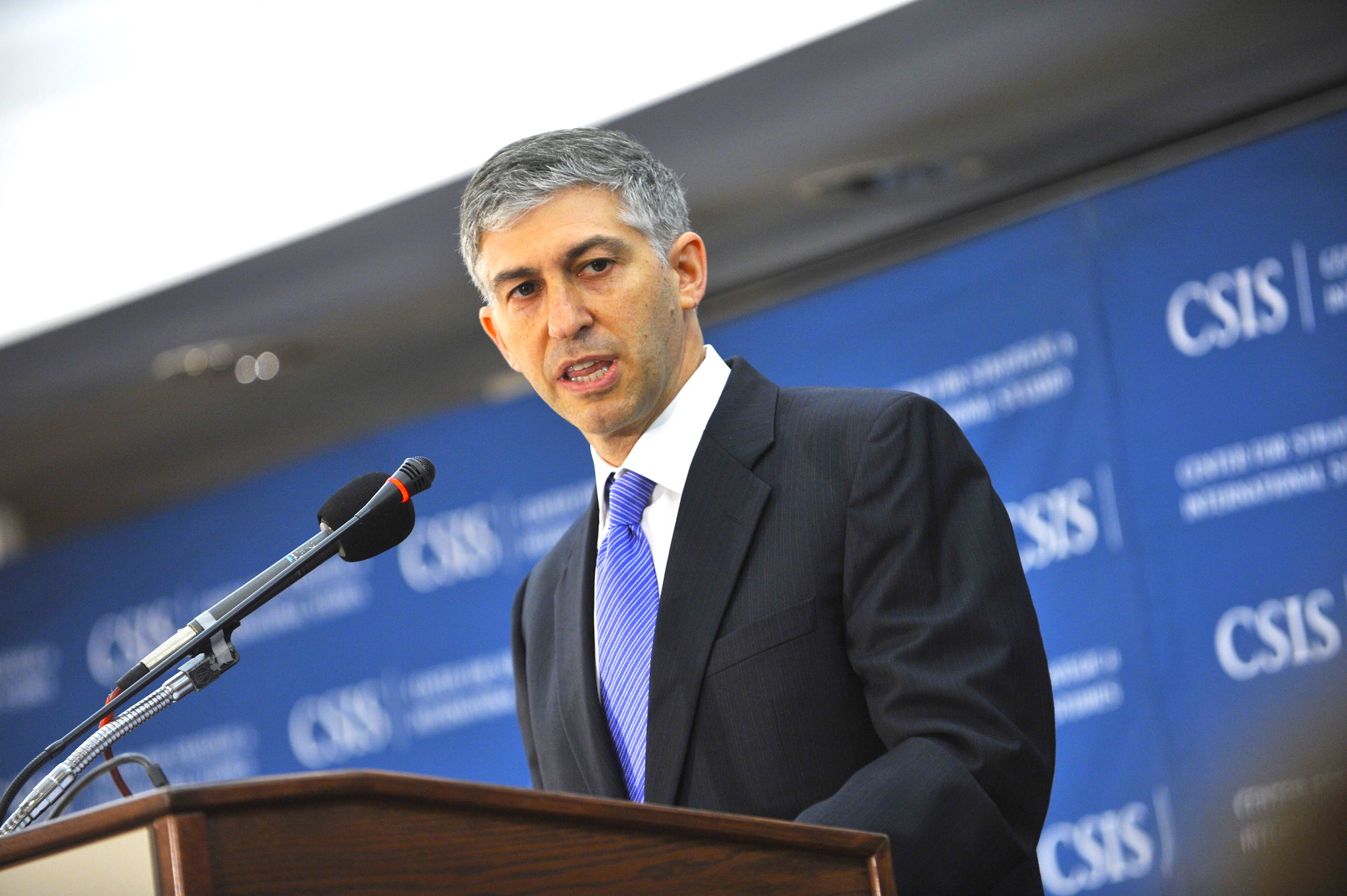
Sept. 20, 2010: Stuart A. Levey, under secretary of treasury for terrorism and financial intelligence, discussing sanctions on Iran. (Center for Strategic & International Studies, Flickr, CC BY-NC-SA 2.0)
Levey identified UN Security Council Resolution 1929, adopted in 2010, which calls for a wide range of actions by member states against Iran over nuclear and missile activity, as crucial to his approach. He sought to exploit the fear of foreign companies that their investment in Iran could be linked to any Iranian activities labeled as “illicit.”
“The operating presumption,” Levey suggested, “should be that virtually all transactions or financial services involving Iran could contribute to its nuclear or missile programs.” Levey saw the establishment of that “presumption” as the key to frightening potential investors away from Iran.
Even though the Treasury sanctions legally apply only to assets and transactions under U.S. jurisdiction, Levey observed, “[W]e have found over the years that many banks and businesses around the world cut off dealings with designated targets…”
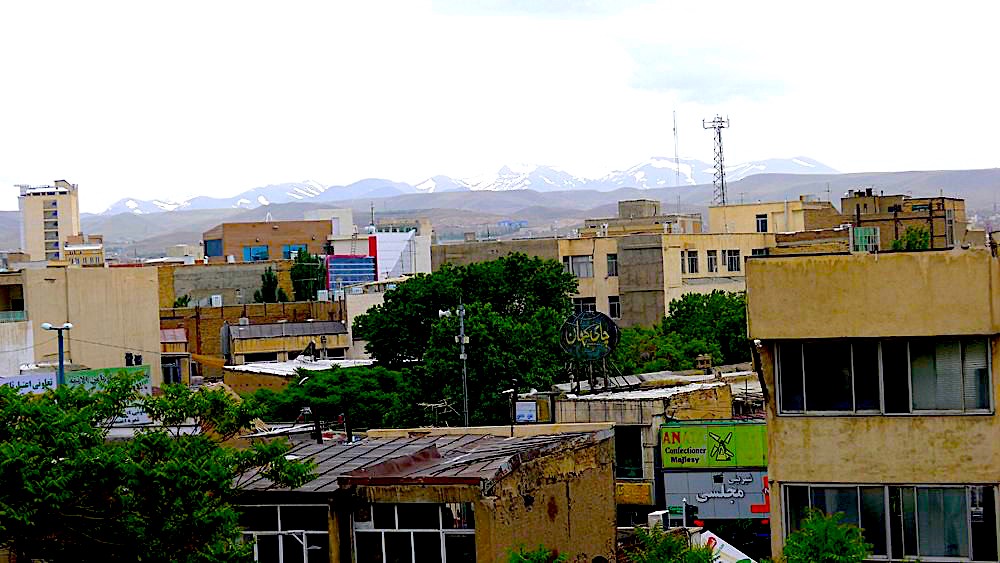
Tehran rooftops, 2012. (shiva1o8, Flickr, CC BY-NC-ND 2.0)
By enriching uranium at the 60 percent level of purity, Iran is applying its own strategy of diplomatic leverage, hoping to force an end to economic sanctions ravaging its economy. Tehran employed the same tactic in 2012, pressuring the Obama administration to drop its insistence that Iran essentially give up its enrichment program entirely.
The Obama administration believed it was well positioned to force Iran to give up its nuclear ambitions. To whittle away at U.S. diplomatic pressure, Iran doubled its total number of centrifuges onsite between May and August 2012, but it never actually used the bulk of that capability to enrich uranium. None of the newly installed centrifuges were even connected with pipes; and only one third of those that were connected were actually enriching. In September 2012, Iran offered to end its policy of 20 percent enrichment in return for the lifting of sanctions. An Obama administration official acknowledged that Iran had gained “leverage” by creating a high degree of capacity, but not using it.
The result was the compromise at the heart of the JCPOA: Iran agreed to give up its ability to produce enough enriched uranium for a nuclear weapon and the U.S. removed its economic sanctions that had blocked Iran from achieving its development goals.
Now, the Biden administration is planning to exploit the crushing sanctions regime it inherited from Trump to extract further concessions from Iran. Those sanctions have brought what the IMF has called “extreme distress” to Iranian economy and society, increasing inflation and unemployment, and sharply reducing popular access to food, healthcare and medicine.
But any notion that U.S. sanctions would result in popular pressure for government concessions on the nuclear deal was contradicted by a survey of Iranian public opinion by the University of Maryland’s School of Public Policy in late 2019 which found that a solid majority of Iranians now questioned whether Iran should have signed the JCPOA in the first place.
Nevertheless, Joe Biden, Secretary of State Blinken and other top officials in the administration are acutely attuned to Israeli strategic thinking. They appear convinced that their ability to pressure Iran through sanctions has been strengthened –– especially after the April 11 Israeli sabotage attack on the Natanz enrichment facility, which will set back Iranian enrichment plans at the facility for at least nine months.
But the Biden team’s hopes that Iran could be coerced to return to the nuclear deal while the U.S. attempts to economically strangle Iran until it accedes to its demands demonstrates a breathtaking lack of perspective. If this delusional mindset prevails, it is likely to lead to a much more serious crisis in the coming months.
Gareth Porter is an independent investigative journalist who has covered national security policy since 2005 and was the recipient of Gellhorn Prize for Journalism in 2012. His most recent book is The CIA Insider’s Guide to the Iran Crisis, co-authored with John Kiriakou, just published in February.
This article is from The Grayzone
The views expressed are solely those of the author and may or may not reflect those of Consortium News.
Please Support Our
Spring Fund Drive!



Ta muchly Mr Porter for this piece…and yes the US govt (WH, Congress and the rest of its agencies) are deeply inflicted with HUBRIS (and hypocrisy)… Moreover how many in the present (never mind Trump/Obama admins) are of a Zionist frame of mind? That what is good for the Occupiers of All Palestine is A-OK and what we, the west and US in particular, should aim for? The Biden admin (and members of his family – akin to Trump) has a large proportion of Zionists – clearly…not good because it would seem that what OAP wants we click our heels and do, whether for family allegiance or political interest. Now I’m not saying, or thinking, that many of our (the corporate-capitalist-imperialist ruling elites) interests and those of the OAP do not coincide. They surely do, all too frequently and atrociously…We presume that we are the imperial, righteous power, but sometimes, often, the tail wags the dog – or their “interests” all too frequently coincide…
This so-called negotiating is almost laughable. Iranians are very skillful negotiators and they will not fall for any enhanced agreement fostered on Israels behalf. The public US position of demanding more concessions is dead before it even starts. Iran has nothing to lose, but Israel and the US have plenty to lose…like their increasingly impotent ability to twist arms. When one stands up and refuses to cower, others see hope. What is really on the table (per Israel/US) is Iran’s conventional missile program. Yemen’s success against western tech is quite telling. No wonder the Israeli’s are scared…they see that their facade of invulnerability and desire to control the entire ME dissolving before their eyes. It is funny that the main reasons (publicly) for entering the JCPOA is nukes…as it was a hot button topic, used to buffalo the public, instigated by Nutsack himself. Recall the stupid address before CONgress? Now Iran can use their ability to enrich to 60% in a similar manner…IE: the nuke weapon threat…regardless having no intention to produce a bomb. It is the Israeli tact coming back to bite them in the ass. But, hey, it was Nutsack himself that put the US/Israel in the ‘nuke box’…now that it has enabled Iran to enrich, they have to continue the fake nuke threat game, all thanks to Israel. The idea that Iran will ditch their missile tech is a pipe dream. It is also reasonable to assume that recent ‘pacts’ with Arab countries is part of the equation as well. Jordan’s recent coup attempt only underlines the lengths the US and Israel will go to keep their toadies in line. Israel wants an Iran that is incapable of defending itself or being able to launch retaliatory strikes, but this is not a publicly viable approach. This is not going to happen. The explosion in Israel today is also of interest. Was it an accident, as claimed in Israel…or Iranian tit for tat? hXXps://southfront.org/large-explosion-at-sensitive-israeli-defense-factory/ Israel seems to have a weapons factory missing. TFB.
Blundering Blinken is the perfect US Secretary of State, cut from the same cloth as Mike Pompeo. Blinken, like Pompeo, is a accomplished liar, just like his Boss, sleepy Joe Biden! Biden has recruited Obama’s B Team of hasbeen Diplomats who promote the delusional mantra of American Exceptionalism? America has proven to be a untrustworthy & devious signatory to the JCPOA & has no right to dictate terms or renegotiate this agreement that they violated by walking away from! The US needs this deal more than Iran does! Iran now has options with its huge China deal & everyone knows that America has exhausted itself with it’s failed policy of Economic sanction warfare? The US Dollar based system & SWIFT is on the way out & Iran knows it, once the Chinese digital Yuan currency becomes a reality, Iran will have no need to transact using the USD & its SWIFT financial system. Once again, the law of unintended consequences shows that America, through its overuse of Sanctions & using the USD as a weapon to punish Nations has forced others too find alternative systems to bypass the restrictions! America has excelled in shooting itself in the foot & hastening its own Imperial decline & demise!
America is the most dangerous country on the planet and based on past performance, the one most likely to nuke those it deems as enemies….The worst but only means possible for these countries to protect themselves is to build there own nukes….So what if Iraq did have “weapons of mass destruction’….Perhaps if it had, the US might have stopped short of bombing it to smithereens.
Biden and Blinken have absolutely no honesty or integrity in this behavior.
“[U]nder the deal the U.S. retains the right to impose sanctions for non-nuclear reasons,” BUT the USA violated the deal ie it is in the wrong.The deal took a great deal of development and Iran was very careful about what it covered. For the USA not only to violate it, but for Biden/Blinken now to retain Trump’s derided actions and want to “box in” Iran with the cruel, illegal unilateral sanctions shows complete lack of any decency. Israel may be of paramount importance to Biden and Blinken, but this issue is of vital international interest and needs genuine commitment to fair policy and action by “democratic” USA and the rest of the countries involved in the JCPOA.
This effing Blinking guy is lost in the thinking of past generations. He seems like a kiss up to me. He is gonna walk out eventually with his tail between his legs. That would be the best outcome for him – and more importantly, for us. So, I hope it happens soon.
~
All bullies eventually get busted. Right between the eyes – metaphorically speaking of course. Thing is – if you are fixated on old ideas for which it is most evident THEY DON’T WORK, then as my old pal Albert used to say – you must be insane!
~
Perhaps some time in mental health institutions would be most beneficial for most of the gubment officials out of the made up city of DC. Especially the ones up so high in their imagination. They are not exceptional, in fact, they seem to represent the worst of us.
~
Just remember back in January of 2020 there was an illegal assassination, and just like with all the illegal wars and acts of aggression of the 21st century coming out from the main bully, not one single individual in the “upper echelon’s” (especially of their own imagination) has ever been held to account. What would Jesus say about that?
~
I’m sorry to inform you, but one of the 10 commandments that Moses bought down from the mountain said – “Thou shall not kill”. Is there confusion on what this means?
~
BK
Who could blame Iran for wanting a nuclear weapon as the quintessential deterrent? Tehran is aware of what happened to Milosevic, Hussein and Gaddafi.
It’s prudent for any sovereign nation independent of Washington, Wall Street or Zionist power to do all it can to acquire a vast trove of nuclear bombs because only then will Washington-militarist-Zionist warmongers decide to back off any notion of outright regime change.
For these countries acquiring nuclear weapons is not only a noble goal but it’s also grounded in self-preservation.
The DPRK understands this dynamic quite well.
I agree entirely. The USA, my own UK government and Israel have no moral right to even make a comment about Iran’s possible wish to develop nuclear weapons, given their own attachment to their massive arsenals. My Tory MP, Peter Gibson, has stated his full support for the UK’s spending tens of billions of pounds of public funds to upgrade and expand the Trident nuclear missile system and the Dreadnought nuclear submarines to launch them. Our PM, Boris Johnson, recently stated that cyber attacks against the UK would be a good enough reason to use these weapons. Iran is a paragon of peace, by comparison.
Interesting info on the UK. I’m based in the U.S.
Thanks for the insightful commentary.
All so very true, James, all so true….Hypocrisy and Hubris all the way from The US, UK and OAP…
TRUE!!! I just wish that for the sake of Iran (which has not invaded another country in over 200 years unlike some I could mention) they would indeed build even a couple of nukes…
And why do we (US, UK, OAP, FR) want Iran so vulnerable? Because we are barbarians…
And Iran has every right to have Allies in the region….Not that we in the west call them that – oh no, can’t have that. BUT we do not belong there (nor do the OAPers)….
Right on target Anne.